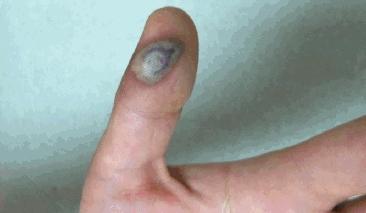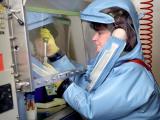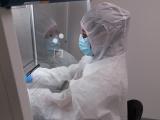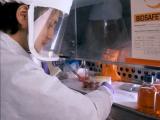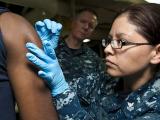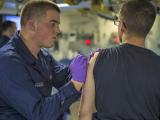A laboratory worker in Boston was infected with vaccinia virus because of a needlestick injury, despite having been vaccinated against the virus 10 months earlier, according to an article today in Morbidity and Mortality Weekly Report.
The article says the infection is the first reported in a US lab worker who had been vaccinated recently in accord with recommendations of the Advisory Committee on Immunization Practices (ACIP). Vaccinia is the virus used in smallpox vaccines.
Initial presentation, treatment
The worker, a 27-year-old staff member in an academic institution, accidentally pricked his thumb on Nov 17, 2013, while recapping a needle he had been using to inoculate an anesthetized mouse with wild-type vaccinia virus, according to the report. He said the mishap occurred when he was distracted by the movement of a mouse in another cage.
The worker immediately washed his hands for about 10 minutes while expressing blood from the wound. A report on the incident was filed the same day, and the man was advised to go to a hospital emergency department immediately if symptoms appeared.
Six days later he sought care for a non-tender rash on his left arm, and an ultrasound exam showed a small collection of fluid at the puncture site. He was diagnosed as having cellulitis and given intravenous cefazolin, followed by oral cephalexin. On Nov 25 he reported to his institution's occupational health clinic with a necrotic lesion at the puncture site along with the arm rash.
A necrotic vaccinia virus infection was diagnosed, and the patient was advised to keep taking cephalexin. Two days later the lesion was stable and the arm rash had resolved. On Dec 10, 23 days after the injury, the lesion was surgically debrided, and by Jan 9 the lesion was healed.
Specimens sent to a state laboratory and the CDC tested positive for an orthopoxvirus, and the Centers for Disease Control and Prevention identified vaccinia virus by tissue culture.
Recapping needles found improper
As required, the occupational health clinic notified the Boston Public Health Commission (BPHC) of the case. The commission visited the lab Nov 26 and found most things in order but identified recapping of needles as a departure from recommended procedures.
The patient, who had worked at the lab since January 2013, had received proper training and had received the ACAM2000 smallpox vaccine on Jan 28. A skin lesion at the site showed that the vaccination "took."
A serologic study by the CDC showed that the patient had high levels of orthopoxvirus immunoglobulin G, suggesting earlier exposure to the virus by vaccination or infection, the report says. But the antibody level necessary for protection against the virus is unknown, as was the viral load caused by the injury.
The report says the ACIP advises that lab workers who handle wild-type vaccinia viruses should be revaccinated every 10 years. Two previous vaccinia infections have been reported in vaccinated workers, but one of them had been vaccinated more than 10 years before exposure, and the other had been vaccinated 6 years preexposure and did not have a vaccine "take."
"Vaccination alone is insufficient as the sole preventive measure against laboratory-acquired orthopoxvirus infections," the report states. "It must be complemented with effective biosafety protocols such as education of laboratory personnel, safe laboratory practice, and incident reporting."
CDC. Laboratory-acquired vaccinia virus infection in a recently immunized person—Massachusetts, 2013. MMWR 2015 May 1;64(16):435-8 [Full text]
